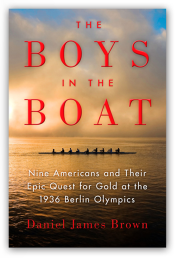While their triumph over the Germans was momentous, the event was largely overshadowed by an even bigger story, one of Jesse Owens and his own incredible success at the Olympic Games. “…the Jesse Owens story was so prominent that summer that it kind of dominated the headlines and this story got a little bit buried because of that… Jesse Owens, the African American track and field star from Ohio, had gone to Berlin and very impressively, he won four straight Gold medals, and because he was African American and this was in front of Hitler, it was an enormous embarrassment to Hitler and his whole white supremacy theory of the world, and it was a sensational story both because of Jesse’s extraordinary accomplishment and also because of the racial implications for the Nazis…” Despite that, the crew team’s victory did make national news at the time, but because there wasn’t a lot of celebration surrounding their win, the story faded from memory over time.
Due to numerous requests from educators, librarians, parents and grandparents who felt that this book would be beneficial to younger audiences, Brown created a separate young readers adaptation of this story. Compared to the adult version, the adaptation is shorter and divided into more chapters, with simplified, age-appropriate language. Additionally, visual elements were incorporated, including a timeline to help young readers keep track of the events, a photo gallery of all the main characters in the book, a diagram of a rowing shell, and more. Brown remarked, “It was very important to me that the heart of the story, through the emotional impact, particularly of General Rantz’s story, the heart of it remained intact, so I worked to make sure that that happened…”

I like the discipline of sticking with the facts… I could make it so much more compelling in this place or that place if I altered the facts, but I like the discipline of having to work within the facts and it’s always a huge challenge, especially when you’re writing about something that happened a long time ago.”


The life you live affirms the conduct you endorse. Remember, your integrity is easier to retain than to recover.”

Podcast: Play in new window | Download
Subscribe: RSS
